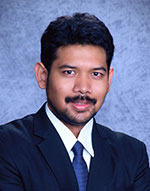Winds of Change
Kernel Azarya (MEM ‘22) talks about how the MEM program helped him transition from the oil and gas industry to his new job in renewable energy.
With their arrays of turbines jutting up to 500 feet out of the ocean and rotating blades measuring as much as 350 feet long, offshore wind farms are impressive. But without what lies below the water, they are no more useful than toys.
That’s where people like Kernel Azarya (MEM '22) come in.
 Azarya graduated in December from Northwestern's Master of Engineering Management (MEM) program and started a job with Prysmian Group, a global company that manufactures and installs electric cable and has operations in 50 countries.
Azarya graduated in December from Northwestern's Master of Engineering Management (MEM) program and started a job with Prysmian Group, a global company that manufactures and installs electric cable and has operations in 50 countries.
Azarya is a project manager for high-voltage submarine cable installation, working with the installation, engineering, and manufacturing teams to connect energy cables to offshore wind turbines. It is only through those cables that the energy being generated by wind farms can reach consumers back on land.
“Ever since I started the MEM program at Northwestern, I have been very interested in working in the clean energy sector,” he said. “I believe the world’s shift to renewable energy is inevitable, and I want to take part.”
Azarya himself is part of the shift. Prior to joining MEM, he worked at an Indonesia-based oil and gas company as a project engineer on offshore oil platforms and their pipelines. He said he is excited to start with a company that has a greater focus on environmental sustainability.
“This is my dream job because it aligns with both my career plan and previous work experience,” he said. “The opportunity to work as a project manager for submarine projects at Prysmian gave me the pivot I needed to get into the renewable energy sector.”
Azarya credited MEM with preparing him to make that pivot. He said there were two specific components of his experience that became the main building blocks in his new foundation.
The first was the NUvention: Energy course. The class brings together a cross-section of students to dive deeply into the sustainable energy field and develop new ventures to promote its growth. The course is taught by MEM director Mark Werwath and adjunct lecturer Ian Weise (MEM '18).
“NUvention: Energy brought me out of my comfort zone,” Azarya said. “I had to do market research on sustainability products and work with my team to work on an innovation that could reduce carbon impacts.”
Azarya took the lessons he learned in that course and applied them to his summer internship — the second key aspect of his MEM experience. Azarya worked from August through November as a construction management intern with Culdesac, a company building the first car-free community in the United States, in Tempe, Ariz.
“My internship provided me with direct experience with construction management to build a sustainable neighborhood that values micro-mobility,” he said. “We replaced roads and parking spaces with trees and common areas. E-bikes and public transportation will be the primary mode of transportation for the residents in place of cars.”
Now armed with those experiences, Azarya’s focus is back offshore, this time to renewable energy instead of offshore oil platforms. His job has him performing project preparations for new wind farms and ensuring that each goes according to plan and stays on budget.
Because of his own experiences, Azarya has become an advocate of the MEM program, particularly for people like him who have a growing body of professional work as an engineer and a desire to move into management.
“My advice for prospective students would be to know what your goals are and what you want to do in your career,” he said. “If you have engineering experience and want to work in a project and product management position related to your field of expertise, then the MEM program would be perfect for you.”

